|
Week 2: August 8-14, 2013 |
Welcome
to the McGill Bird Observatory weekly report.
Click here for a complete listing of our archives.
Comments or
questions are welcome at "mbo AT migrationresearch.org".
|
PICTURE
OF THE WEEK: |
|
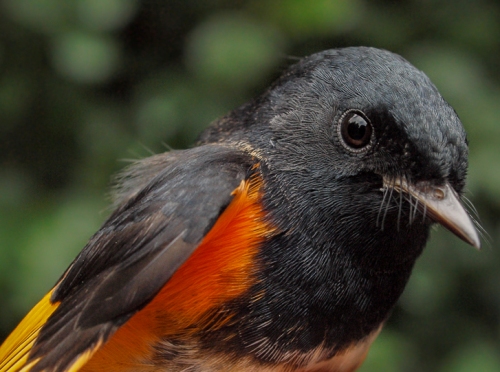
Mid-August is when American Redstarts dominate at MBO, and this year appears to
be no exception, with 22 of them banded this week, including the adult male above.
(Photo by Simon Duval)
-
|
|
|
THIS WEEK |
THIS FALL |
2013 TOTAL |
SITE TOTAL |
|
# birds (and species) banded |
160 (30) |
460 (45) |
1755 (81) |
43267 (113) |
|
# birds (and species) repeat |
63 (22) |
130 (25) |
460 (45) |
8441 (70) |
|
# birds (and species) return |
8 (5) |
15 (8) |
170 (30) |
1379 (38) |
|
# species observed |
75 |
95 |
154 |
208 |
|
# net hours |
490.0 |
1050.0 |
4406.8 |
73696.5 |
|
# birds banded / 100 net hours |
30.6 |
42.9 |
39.8 |
58.7 |
|
|
Note: table does not include nocturnal banding (owls) |
|
Banders-in-charge: Simon Duval, Gay Gruner
Assistants: Nicolas Bernier, Sue Bishop, Marie-France Boudreault, Rui de Jesus, Adam Feller, Marianne Gagnon, Marcel Gahbauer, Nathalie Gendron, Alison Hackney, Lisa Keelty, Barbara MacDuff, Benoit Piquette, Jean Rogez, Ahmad Shah, Patricia Stotland, Elise Titman, Rodger Titman, Carine Touma
IMPORTANT: MBO has been selected as one of five finalists in the Jamieson Vitamins "Call for the Wild" contest for 2013. To support MBO, all you need to do is vote daily between August 19 and September 15 by visiting the contest Facebook page (no login required). Four other organizations are competing for their share of $100,000, and the amount allocated to MBO will be entirely dependent on the number of votes received. Please help us succeed with this important fundraiser by voting for MBO every day!
Notes: As has been the case most years, migration seemed to taper off a bit in week 2 after a strong start to the season in week 1. Even though the number of birds banded in week 2 was barely more than half of what we had in the first week of the season, the cumulative total of 460 is the second-best start to fall in 9 years, behind only last year's record pace. The number of species observed this year dropped to 75, with between 30 and 46 daily. However, the total of 95 so far is the highest ever over the first two weeks of fall - a reflection of both the number of species present, and the dedicated efforts of our many observers to ensure that we document all the species in the area, not just those that we band. The 11 species observed for the first time this season were Sharp-shinned Hawk, Red-shouldered Hawk, Merlin, Solitary Sandpiper, Greater Yellowlegs, Chimney Swift, Eastern Wood-Pewee, Northern Rough-winged Swallow, Barn Swallow, Mourning Warbler (actually the first of 2013), and Canada Warbler. The two warblers were also banded for the first time this fall, as were Great Crested Flycatcher and Warbling Vireo.
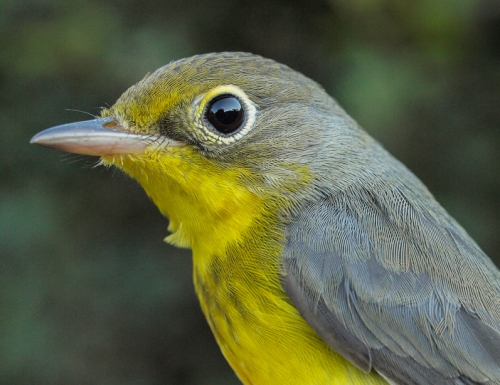
Of the 26 warbler species that have been banded at MBO, two of the less common ones are Canada Warbler (above), and Mourning Warbler (below), both of which peak during fall migration in August.
(Photos by Simon Duval)
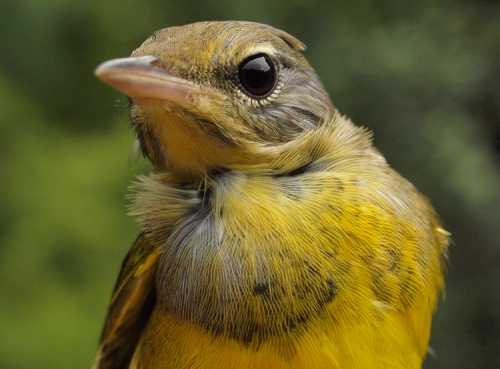
|
This week’s top 10 [last week's rank in brackets]
# individuals banded |
mean # individuals observed daily |
1. Song Sparrow (33) [1] |
1. Cedar Waxwing (30) [1] |
2. American Redstart (22) [5] |
2. Song Sparrow (22) [2] |
3. Cedar Waxwing (10) [2] |
3. Black-capped Chickadee (20) [6] |
4. Black-capped Chickadee (9) [7] |
4. American Goldfinch (18) [5] |
4. Common Yellowthroat (9) [7] |
5. American Robin (14) [3] |
6. Ovenbird (8) [-] |
6. American Crow (13) [4] |
7. Traill's Flycatcher (7) [-] |
7. Blue Jay (7) [7] |
7. Red-eyed Vireo (7) [6] |
7. American Redstart (7) [-] |
7. Rose-breasted Grosbeak (7) [7] |
9. Northern Cardinal (7) [-] |
10. Canada Warbler (5) [-]
|
10. Gray Catbird (5) [9] |
|
The impressive start to the season continues for Song Sparrow, with another 33 banded this week for a season total to date of 129, ahead of the previous high of 112 over the first two weeks of fall 2006, and nearly double the average of 67 during this period. Conversely, the 10 American Redstarts banded last week was the slowest start to fall for that species since 2008, but it jumped up to second place this week with more typical numbers. Cedar Waxwing tapered off this week with just 10 more individuals banded. For the second week in a row we banded equal numbers of Black-capped Chickadees and Common Yellowthroats, with both moving up to a tie for fourth place this week. In both cases, most were juveniles, likely from local breeders. The 8 Ovenbirds banded this week was the highest count ever for week 2, although in the peak of their migration in late August and early September we have banded as many as a dozen in a week. The three-way tie for seventh place included Traill's Flycatcher, which typically peaks in week 2; last year we banded 14 of them in this week. Canada Warbler numbers were a bit below average last fall, so we hope that their appearance in this week's top ten is an encouraging sign that will carry on into week 3, which on average has coincided with the peak of their fall migration.
Again this week, Cedar Waxwing and Song Sparrow were the species most frequently observed on site. Black-capped Chickadees were more active this week, jumping up to third place, and bumping down the trio of "Americans" (Goldfinch, Robin, and Crow) to occupy the middle of the top ten. After them, there was quite a drop in abundance to the trio of species that averaged 7 individuals per day - Blue Jay, American Redstart, and Northern Cardinal. Although we can be quite certain there are more than 5 Gray Catbirds at MBO presently (breeding pairs plus their offspring), they are perhaps being a bit quiet while the adults moult, and on average we recorded just 5 individuals per day this week.
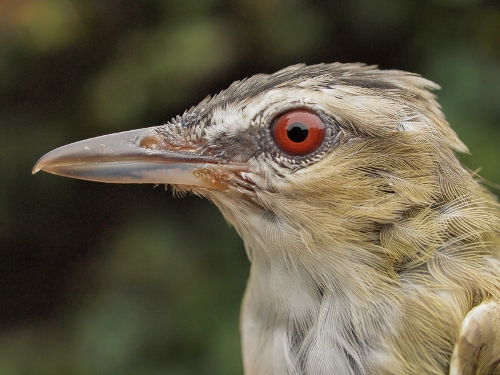
Red-eyed Vireo migration typically peaks at MBO in September, but the species is often already among the top ten species banded as early as mid-August, as was the case this year again in week 2. This adult is currently looking a bit scruffy as it goes through its prebasic moult, but can be aged by the colour of its eye.
(Photo by
Simon Duval) |
Migration was relatively slow over the second half of week two, but that is part of the lull we commonly see between the first wave of early migrants and the next group of species to move south through MBO. We look forward to welcoming other species back to the area in week 3 and sharing them in next week's report.
|
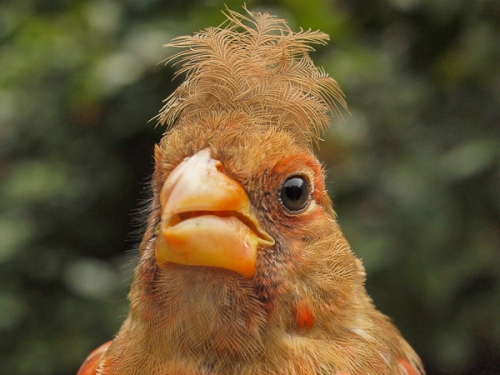
Northern Cardinals are adorable enough at this time of year to be featured two weeks in a row!
(Photo by Simon Duval)
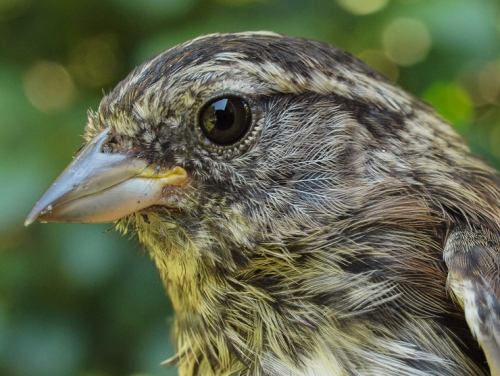
The "fresh crop" of sparrows in August can always be a bit of a challenge as juveniles of many species are dull and heavily streaked. This White-throated Sparrow is quite different from what is shown in most field guides ... and rather similar in appearance to juvenile Song Sparrows.
(Photo by Simon Duval)
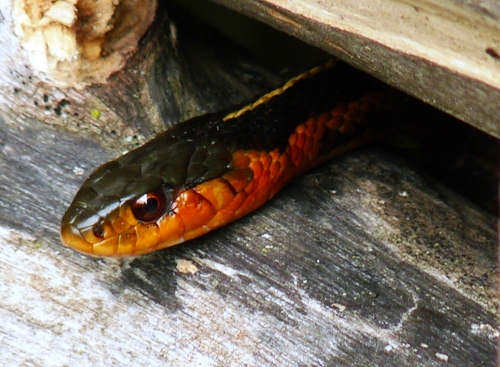
One of our local garter snakes has taken up residence in our wood pile.
(Photo by
Marcel Gahbauer)
|







